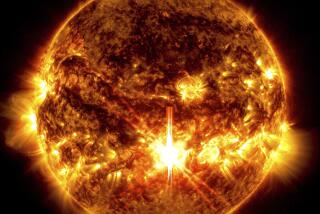Solar storm is a bit of a dud -- but wait, there’s more to come
“The shock has arrived!”
At about 5:45 a.m. Eastern time Thursday, the geomagnetic storm from a massive solar flare that rippled the surface of the sun on Tuesday night finally reached the Earth’s atmosphere.
The Facebook page for the National Oceanic and Atmospheric Administration NWS Space Weather Prediction Center made the announcement. But so far, the storm has been a bit of a dud.
That’s good news for people who like their GPS accurate and their flights on time.
Space-weather enthusiasts monitored the storm at sites such as SpaceWeather.com, which said Thursday morning that the “impact was weaker than expected,” causing only a “mild” geomagnetic storm. The site also said the storm could “intensify in the hours ahead.”
Severe solar storms can wreak havoc with GPS navigation systems, force airlines to reroute flights and even knock out major power grids.
Grids were A-OK as of about 10:45 a.m. Eastern (7:45 a.m. Pacific), according to Kimberly Mielcarek, spokeswoman for the North American Electric Reliability Corp., which monitors the nation’s major power grids.
The solar storm “has had no impact on the bulk power system,” she said in an interview with The Times on Thursday morning. But utilities “continue their normal monitoring pattern ... for any abnormal energy flows.”
Alex Young, a solar physicist at NASA Goddard, told The Times on Thursday morning that the storm was low level. It did, however, create some great auroras -- those gorgeous light displays in the sky -- as far south as the Great Lakes region, he said.
Although this solar storm fell short of predictions, you may want to brace yourself for the years ahead.
Solar flare activity and its fallout on Earth are expected to heat up. We’re only about four years into the current 11-year solar cycle.
Young said that, around 2013, solar activity is expected to peak with “a couple of CMEs a day.” That’s coronal mass ejection – the mass of magnetized material that the sun hurls out after a flare. “But they have to be pointed at Earth. ... We would expect a couple a week to reach the Earth.”
These are unlikely to be massive geomagnetic storms. The colossal storms are expected farther into the cycle, perhaps in 2014, Young said. Large flares and their storms tend to happen as a solar cycle wanes.
He likened the solar flare activity to the release of energy with earthquakes -- “a lot of small ones ... and then every so often the big one.”
With a colossal solar flare, “radio blackouts and things like that” happen fairly immediately after the flare, Young said in an earlier interview with The Times.
Those geomagnetic storms and “can last six to 12 hours,” Young said, “but the largest ones can last for days.”
ALSO:
Breakthrough in organ transplants
Clues about humans from gorilla DNA
Hawaii flooding: Disaster on two islands
More to Read
Sign up for Essential California
The most important California stories and recommendations in your inbox every morning.
You may occasionally receive promotional content from the Los Angeles Times.











